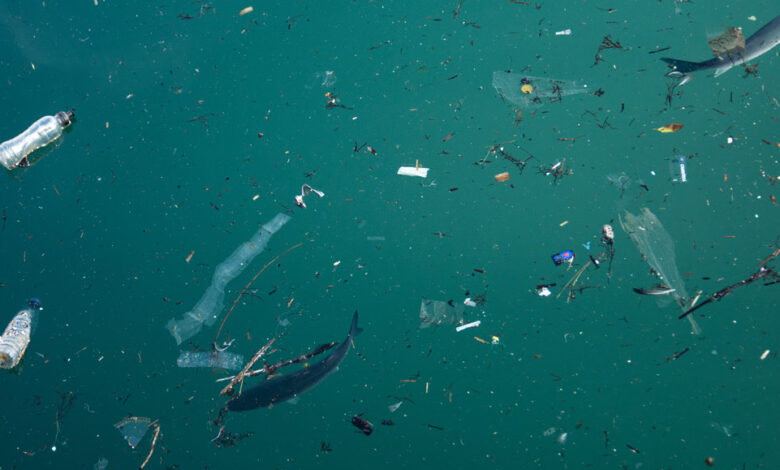Some bacteria in wastewater can break down a common plastic


bacteria: (singular: bacterium) Single-celled organisms. These dwell nearly everywhere on Earth, from the bottom of the sea to inside other living organisms (such as plants and animals). Bacteria are one of the three domains of life on Earth.
bond: (in chemistry) A semi-permanent attachment between atoms — or groups of atoms — in a molecule. It’s formed by an attractive force between the participating atoms. Once bonded, the atoms will work as a unit. To separate the component atoms, energy must be supplied to the molecule as heat or some other type of radiation.
carbon: A chemical element that is the physical basis of all life on Earth. Carbon exists freely as graphite and diamond. It is an important part of coal, limestone and petroleum, and is capable of self-bonding, chemically, to form an enormous number of chemically, biologically and commercially important molecules.
chemical: A substance formed from two or more atoms that unite (bond) in a fixed proportion and structure. For example, water is a chemical made when two hydrogen atoms bond to one oxygen atom. Its chemical formula is H2O. Chemical also can be an adjective to describe properties of materials that are the result of various reactions between different compounds.
chemical reaction: A process that involves the rearrangement of the molecules or structure of a substance, as opposed to a change in physical form (as from a solid to a gas).
degrade: To break down into smaller, simpler materials — as when wood rots or as a flag that’s left outdoors in the weather will fray, fade and fall apart. (in chemistry) To break down a compound into smaller components.
detergent: A compound derived from petroleum products, often used for cleaning. Detergents work by breaking up and surrounding dirt particles or oily substances, so that they can be washed away with water.
develop: To emerge or to make come into being, either naturally or through human intervention, such as by manufacturing.
environment: The sum of all of the things that exist around some organism or the process and the condition those things create. Environment may refer to the weather and ecosystem in which some animal lives, or, perhaps, the temperature and humidity (or even the placement of things in the vicinity of an item of interest).
environmental science: The study of ecosystems to help identify environmental problems and possible solutions. Environmental science can bring together many fields including physics, chemistry, biology and oceanography to understand how ecosystems function and how humans can coexist with them in harmony. People who work in this field are known as environmental scientists.
enzymes: Molecules made by living things to speed up chemical reactions.
focus: (in behavior) To look or concentrate intently on some particular point or thing.
gene: (adj. genetic) A segment of DNA that codes, or holds instructions, for a cell’s production of a protein. Offspring inherit genes from their parents. Genes influence how an organism looks and behaves.
genetic: Having to do with chromosomes, DNA and the genes contained within DNA. The field of science dealing with these biological instructions is known as genetics. People who work in this field are geneticists.
laser: A device that generates an intense beam of coherent light of a single color. Lasers are used in drilling and cutting, alignment and guidance, in data storage and in surgery.
microbe: Short for microorganism. A living thing that is too small to see with the unaided eye, including bacteria, some fungi and many other organisms such as amoebas. Most consist of a single cell.
microbiologist: Scientists who study microorganisms, the infections they might cause or ways that they can interact with their environment.
microplastic: A small piece of plastic, 5 millimeters (0.2 inch) or smaller in size. Microplastics may have been produced at that small size, or their size may be the result of the breakdown of water bottles, plastic bags or other things that started out larger.
microscope: An instrument used to view objects, like bacteria, or the single cells of plants or animals, that are too small to be visible to the unaided eye.
molecule: An electrically neutral group of atoms that represents the smallest possible amount of a chemical compound. Molecules can be made of single types of atoms or of different types. For example, the oxygen in the air is made of two oxygen atoms (O2), but water is made of two hydrogen atoms and one oxygen atom (H2O).
nano: A prefix indicating a billionth. In the metric system of measurements, it’s often used as an abbreviation to refer to objects that are a billionth of a meter long or in diameter.
organism: Any living thing, from elephants and plants to bacteria and other types of single-celled life.
particle: A minute amount of something.
plastic: Any of a series of materials that are easily deformable; or synthetic materials that have been made from polymers (long strings of some building-block molecule) that tend to be lightweight, inexpensive and resistant to degradation. (adj.) A material that is able to adapt by changing shape or possibly even changing its function.
polyester: A synthetic material used chiefly to make fabrics. The actual chemical name for the material used is polyethylene terephthalate.
polyethylene terephthalate: A commonly used type of plastic, usually referred to simply as PET. It can be produced as strong, stable fibers for use in making clothing. It also is the basis of many plastic beverage bottles (such as milk jugs) and semi-hard food packages (often used for produce). When used in fabrics, it’s simply known as polyester. To identify these plastics in goods other than clothing, they tend to carry a labeled on the bottom or side with the number 1 surrounded by the triangular “chasing arrows” symbol and the acronym PET or PETE below the triangle.
scanning electron microscope: (also known as SEM) A scientific instrument in which the surface of a specimen is scanned by a beam of electrons that are reflected to form an image.
skeptical: Not easily convinced; having doubts or reservations.
solution: A liquid in which one chemical has been dissolved into another.
strain: (in biology) Organisms that belong to the same species that share some small but definable characteristics. For example, biologists breed certain strains of mice that may have a particular susceptibility to disease. Certain bacteria or viruses may develop one or more mutations that turn them into a strain that is immune to the ordinarily lethal effect of one or more drugs.
taint: To contaminate something with an unexpected, unnatural or illegal substance.
technology: The application of scientific knowledge for practical purposes, especially in industry — or the devices, processes and systems that result from those efforts.
wastewater: Any water that has been used for some purpose (such as cleaning) and no longer is clean or safe enough for use without some type of treatment. Examples include the water that goes down the kitchen sink or bathtub or water that has been used in manufacturing some product, such as a dyed fabric.



